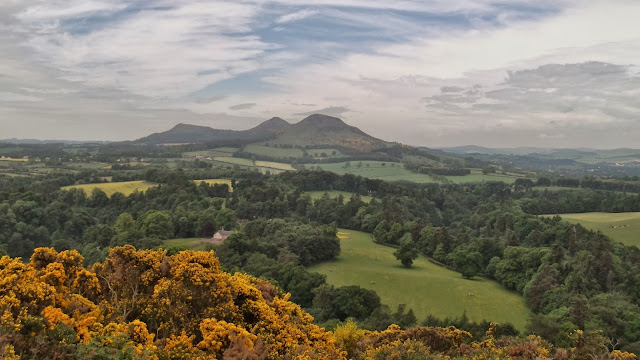Saturday we sent south of Edinburgh to the “Scottish Borders”
area to see some amazing history. The
Borders is one of the Council Areas (Counties) of Scotland. The area is basically surrounded with
Edinburgh on the north, Dumfries on the West, the North Sea on the East, and
the English border on the South. This
area is rich in Scottish history and the Wars of Independence between Scotland
and England were fought in this region.
There were eight of the senior missionaries on this trip and
we first drove to the Leaderfoot Bridge.
The drive was a wee bit wet from the rain, but it was still beautiful as all the fall colors are showing. This bridge was built in 1780 to provide a
connection between the town of Jedbrough and Edinburgh. The bridge crosses the River Tweed. This river winds through the borders and for
the last 20 miles before it empties into the North Sea it is the border between
Scotland and England.
We then drove to the Melrose Abbey. This abbey was founded in 1136 A.D. by King
David I and was the first monastery of the Cistercian order established in
Scotland. The abbey was added to through
the centuries. Most of the abbey was
built in the 13th and 14th century and is one of the best
preserved abbeys in Scotland. King
Alexandeer II (died 1249) is buried in the abbey. The abbey is also the burial place of Robert
the Bruce’s heart. His body was interred
at the Dunfermline Abbey. This abbey is
regarded as one of the most magnificent examples of medieval architecture
anywhere in the British Isles
This is a marker for Robert the Bruce's heart. There is a heart buried here, but it is not the heart of Bruce. He was a King and his heart would have been buried in the Abbey. the marker states.. "A Noble hart may have nane ease gif freedom failye". Translated it says that a "noble heart cannot be at peace if freedom is lacking". The symbol on the marker is what was on the lead casket discovered in the abbey.
On his deathbed in 1329, Robert the Bruce asked that his heart should be carried into battle against the "Infidels" because he himself had not been able to go on a Crusade. (Removing internal organs after death was a common practice in those days). Bruce's body was buried in Dunfermline Abbey and when it was exhumed in 1818 it was found that his ribs had been sawn through, indicating that his heart had indeed been taken from his body.
Sir James Douglas is said to have taken Bruce's heart in a casket with him to Spain in 1330 but, in a battle against the Moors, Douglas was killed. Sir William Keith brought Bruce's heart back to Scotland and it was buried in Melrose Abbey. In 1921, during excavations beneath the Chapter House at Melrose Abbey, a conical leaden casket was discovered. It measured 10 inches high and was 4 inches in diameter at the base but tapering towards the top
Next we drove to Scott’s View. The view overlooks the winding River Tweed
and was a favorite spot of Walter Scott,
the Scottish poet. According to a
popular story, Sir Walter Scott stopped at this point so often on the way to
his home at Abbotsford, that his horses would halt without command. After his death in 1832, his funeral cortège
passed this way en route to his burial at Dryburgh abbey, and his horses
stopped at his favorite view to allow their master a last look at the Borders
landscape.

Next stop was Dryburgh Abbey. This abbey was founded in 1150. It was burned by the English troops in 1322,
after which it was restored only to be again burned by Richard II in 1385, but
flourished in the 15th century.
It was finally destroyed in 1544 This abbey is the resting place of Sir Walter
Scott.
This is the burial spot of Sir Walter Scott
Our last stop was Jedburgh Abbey. This abbey is situated in the town of
Jedburgh and is only 10 miles north of the border with England. Jedburgh is the largest town between
Newcastle and the Scottish capital of Edinburgh. The abbey dates back to 1118 and King David I
of Scotland
It sounds like we drove all day to see these places, but all of this was within about 10-12 miles along highway A68. It was really an enjoyable day. Scottish history is so rich.








No comments:
Post a Comment